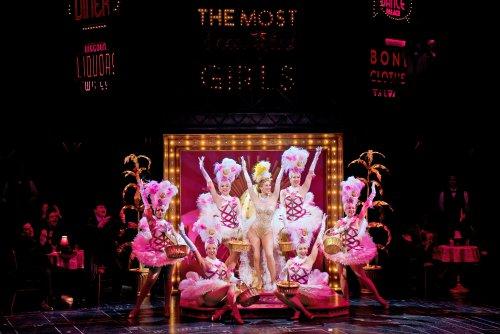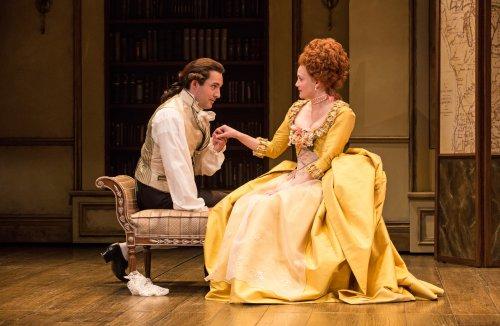The Stratford and Shaw Festivals 2017
The Two Best-Kept Theatergoing Secrets in North America.

Blythe Wilson as Miss Adelaide with members of the company of the Stratford Festival’s production of “Guys and Dolls” (Photo credit: Cylla von Tiedermann)
[avatar user=”David Kaufman” size=”96″ align=”left”] David Kaufman, Critic[/avatar]Apart from two years ago, when personal developments required me to cancel my scheduled trip at the last minute, the present summer marked my 18th consecutive year at the Shaw Festival at Niagara-on-the-Lake and my 12th at the Stratford Festival–both in Canada. (Stratford is about a 90-minute drive from the Toronto airport, and Niagara-on-the-Lake is an hour or so from Buffalo.) What any theatergoer who’s never been to either Festival doesn’t know is that each is the best-kept theatergoing secret in North America. That’s because they are true repertory theaters, and there’s nothing to compare with seeing the same actor in one play in the afternoon and then in a very different production in the evening. And for the most part, every actor in each company is doing just that: there are matinees and evening performances every day of the week, except for Monday, when both Festivals are dark. (Each Festival also has four different theaters.)
Though there were several close runners-up, the highlight of the seven shows I saw at Stratford this year was Guys and Dolls, directed and choreographed by Donna Feore, who did the smashing choreography for Stratford’s A Chorus Line last year. With dancing that’s at least as good as any currently on Broadway and far better than most, the ensemble stopped the show on more than one occasion. And the performance I attended actually included an understudy for Adelaide–the vulnerable yet wily Blythe Wilson, who sniffles perfectly on cue. With a prologue that was all in black-and-white before suddenly shifting into 1950’s Technicolor, the design was also nothing to sneeze at, featuring Michael Gianfrancesco’s sets, Dana Osborne’s costumes, and Michael Walton’s neon lighting. Unsurprisingly, the Stratford’s current Guys and Dolls has recently been extended.

Seana McKenna as Aurélie, The Madwoman of Chaillot with members of the company of the Stratford Festival’s production of Giraudoux’s “The Madwoman of Chaillot” (Photo credit: Cylla von Tiedermann)
If both Giraudoux’s The Madwoman of Chaillot and The Changeling (a rarely performed Jacobean tragedy by Thomas Middleton and William Rowley) failed to work, it was not due to Seana McKenna’s voluptuous performance as the title character in the first nor to Mikaela Davies’ sensuous Beatrice-Joanna in the later. It rather was due to the challenges posed by staging anything in the Tom Patterson Theatre. Almost literally a barn of a space, the Tom Patterson is a rectangular theater-in-the-round, so to speak, and no matter where you’re seated, you feel like you’re missing some of the production. (It’s even worse than the sight-lines and the staging problems encountered by directors at New York’s Circle in the Square Theater.) The Tom Patterson is actually going to be closed for at least the next year, when it’s being completely torn down and rebuilt from the ground up.
After Guys and Dolls, the sold-out hit at Stratford this year is Canadian Kate Hennig’s new play The Virgin Trial, at the Studio Theatre, a modern-day telling of “Bess,” or the 15-year-old Elizabeth, about whom there has always been much intrigue and unanswered questions–was she, for instance, secretly married and did she have an abortion–making it the perfect subject for a contemporary playwright. Hennig focuses on the issues of celebrity and reputation as they pertained to the young princess the year after her father, Henry VIII, died and she became Queen. Bess comes into firm and vital shape by a commanding Bahia Watson, in the role.

Tyrone Savage as Joseph Surface and Shannon Taylor as Lady Teazle in a scene from the Stratford Festival’s production of Sheridan’s “The School for Scandal” (Photo credit: Cylla von Tiedermann)
Another highpoint at Stratford this year was a delicious and delightfully smart version of Richard Sheridan’s 1777 comedy The School for Scandal, directed by Antoni Cimolino, who has also been Director of the Stratford Festival itself, since 2007. Apparently inspired by Hogarth, Julie Fox’s sets were as sublime as her voluminous costumes for the large cast featuring a shrewd Shannon Taylor as Lady Teazle controlling the jejune Monice Peter as Maria. Though I saw a London production of School for Scandal years ago, this was the first time I realized how similar the plot is to Les Liasons Dangereuses, with elderly, scheming scoundrels encouraging the lascivious behavior of a newcomer in their midst to philandering ways.
Still another high point at Stratford was a contemporary update, in rhyme, of Moliere’s Tartuffe, as adapted by Ranjit Bolt (whose uncle was the late, great writer Robert Bolt, of both Lawrence of Arabia and A Man for All Seasons fame). Under Chris Abraham’s direction, Tom Rooney as the title character unmistakably evokes Rasputin, with long straggly hair, a long black monk’s robe, and a definite Russian accent. It’s a fitting interpretation, since Rasputin was a real-life Tartuffe, who Moliere actually based on a Cardinal that manipulated Louis XIV’s mother Anne of Austria–just as Rasputin, another hypocritical religious figure, manipulated Tsar Nicholas’s wife Alexandria. Though bordering on being over the top, the entire ensemble seemed to cavort with as much pleasure on stage as they gave to those of us in the auditorium, breaking out into fights and shouting matches that appeared scarily real.

Members of the company of the Stratford Festival’s production of Gilbert and Sullivan’s “H.M.S. Pinafore” (Photo credit: Cylla von Tiedermann)
Although missing the Stratford’s productions of Shakespeare’s Twelfth Night, Romeo and Juliet, and Timon of Athens–not to mention a production of Treasure Island–this year, I did catch their replica British version of an early, London, Savoy-Theatre-production of Gilbert and Sullivan’s H.M.S. Pinafore from yesteryear.
Though it’s usually a pleasure to turn from the more sedate Stratford to the Shaw Festival, in the gorgeous Victorian town of Niagara-on-the-Lake (only a 20-minute drive from Niagara Falls), given Stratford’s vastly superior Guys and Dolls, I was disappointed with the other big musical this trip: the Shaw’s revival of Me and My Girl. But then, I realized that it really amounted to the difference between a British music hall-influenced musical, and one of Broadway’s greatest: and there’s really no comparison. The first is so smart–on every level–the second so lightweight. Not that this was a revelation. That’s what made Broadway musicals during their Golden Age so special and their own art form. Lacking any oomph or pizzazz, the only real asset of the Shaw’s Me and My Girl is Michael Therriault’s athletic and even acrobatic Bill. Shaw regular Sharry Flett was also a welcome presence as the controlling Duchess.

Tom McCamus as King George III and Chick Reid as Queen Charlotte in the Shaw Festival’s production of Alan Bennett’s “The Madness of George III” (Photo credit: David Cooper)
Under Kevin Bennett’s stewardship, the Shaw’s The Madness of George III proved an intriguing take on Alan Bennett’s brilliant play from 1991. And having seen the original both at the National Theatre in London and at BAM in New York, I feel like I know what I’m talking about. The Shaw version proved absolutely divine on every level: the entire ensemble was pitch-perfect–given the unusual twist of having many of the male characters played by women (albeit dressed as men), and vice versa. As the “King,” Tom McCamus gave even Nigel Hawthorne a run for one’s memoryof the original, as did the female Chick Reid’s “Queen.”
Since the story has been told about a hundred times too often, I was actually surprised by how much I appreciated Dracula, which features an elegant adaptation by Liz Lochhead that’s reminiscent of The Elephant Man. The production reminded me of the 1977 Bernard Pomerance play as well, in many ways, beginning with a set that features Victorian asylums and hospital curtains shifting this way and that. It also brought to mind both Max Von Sydow and Linda Blair in The Exorcist as well as Anthony Hopkins in The Silence of the Lambs. But then, I realized those two works probably had Dracula in mind when they were created, instead of the other way around. Lochhead’s adaptation zooms in on feminist mores of the period, pitting the young and free-spirited Lucy (Cherissa Richards), the first to succumb to the vampire’s lures, against her slightly older and more sedate sister Mina (Marla McLean).

Sara Topham as Joan, Benedict Campbell as the Archbishop of Rheims and Wade Bogert-O’Brien as the Dauphin in the Shaw Festival’s production of “Saint Joan” by George Bernard Shaw (Photo credit: David Cooper)
Beyond Me and My Girl and Dracula, the big Shaw production this season is G.B. Shaw’s own Saint Joan, which comes to vivid life under the direction of Tim Carroll. Though the words and ideas are still front and center, they are embodied by honest-to-goodness characters you really care about, featuring Sara Topham as a haughty, sure-of-herself Joan, or Maid of Orleans, and stalwart Shaw-actor Benedict Campbell as the Archbishop of Rheims. Campbell is also the busy-body “Cop” in the Shaw’s version of Middletown, Will Eno’s Our Town gone wrong, which perhaps perfectly reflects the life we’re all compelled to live today, making it a difficult play to like, under any circumstances. It’s really a series of vignettes, rather than a play, anyway.
The matinee on day five, at the Royal George Theatre–one of four theatres at the Shaw–was Dancing at Lughnasa, Brian Friel’s lovely, bittersweet, autobiographical “memory” play about his mother and four aunts in rural Ireland. It was yet another marvelous, Shaw production, perfectly acted by most, if not every member of the ensemble.

Sanjay Talwar as Remarkable Rocket and PJ Prudat as Dragonfly in the Shaw Festival’s production of Kate Hennig’s “Wilde Tales” (Photo credit: David Cooper)
Oscar Wilde’s Victorian fairy tales–including ‘The Happy Prince,” “The Selfish Giant” and “The Remarkable Rocket”–are given imaginative zest in the hour-long Wilde Tales, as adapted for the stage by Kate Hennig (the very same who wrote Stratford’s The Virgin Trial, this year) and incorporate a large throng of well-trained children from the audience as a background support team. (The director and performers have apparently worked with the children beforehand.) With Jennifer Goodman’s inventive costume designs, Sanjay Talwar proves especially effective as the “Remarkable Rocket,” or the firecracker that time and again fizzles, instead of going off, without ever losing his pride. Talwar is also a somewhat bewildered Joe Clark, one of Canada’s shortest-lived prime ministers, in Michael Healey’s 1979, a political satire in which multiple Canadian political figures are played with winning results by both Marion Day and Kelly Wong.
I was less impressed with the Shaw’s current presentation of G.B. Shaw’s Androcles and the Lion, which relied on too much extraneous audience participation, and with their version of Branden Jacobs-Jenkins’ An Octoroon. But to emphasize that I admired eight out of ten offerings should emphasize just how good the Shaw Festival continues to be.
For more information about the festivals’ 2018 seasons, visit http://www.stratfordfestival.com and http://www.shawfest.com






Leave a comment